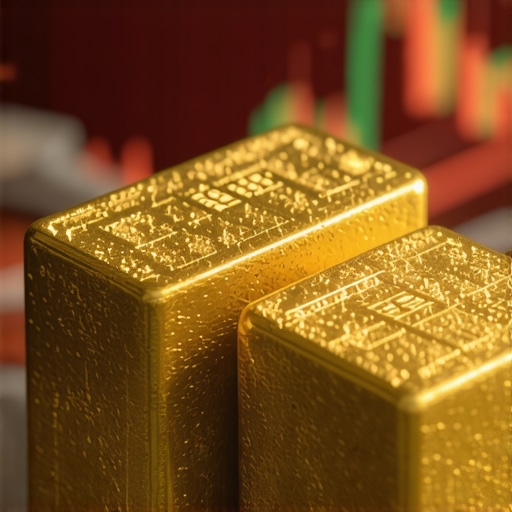Unraveling the Dynamics: How Central Bank Gold Purchases Shape 2025 Price Movements
As we approach 2025, the strategic gold acquisitions by central banks emerge as pivotal factors influencing global gold prices. These sovereign entities, traditionally viewed as custodians of monetary stability, increasingly turn to gold to diversify reserves amidst geopolitical tensions and monetary policy uncertainties. This trend raises critical questions for investors and policymakers alike about the future trajectory of gold valuation, emphasizing the need for a nuanced understanding of the interplay between central bank actions and market dynamics.
Central Bank Gold Accumulation: A Strategic Reserve Diversification
Over the past decade, central banks have shifted from net sellers to net buyers of gold, with 2022 and 2023 witnessing record purchase volumes. This shift reflects a strategic move to hedge against inflation, safeguard against currency devaluation, and bolster national reserves. Notably, countries like Russia and China have significantly increased their gold holdings, signaling a potential de-dollarization trend that could influence commodity markets, including gold.
Market Sentiment and Price Speculation: The Role of Sovereign Purchases
Market analysts suggest that sustained central bank buying can act as a bullish signal, creating upward price momentum. Conversely, if these purchases slow or reverse, prices might face downward pressure. The market’s perception of central bank motives—whether for reserve accumulation or geopolitical signaling—can amplify price volatility, especially in the context of emerging macroeconomic uncertainties.
How Will Central Bank Gold Purchases Affect 2025 Gold Prices? An Expert Perspective
Expert forecasts indicate that increased central bank demand could underpin a bullish trend for gold in 2025, particularly if accompanied by geopolitical tensions and inflationary pressures. However, the timing and scale of these purchases, coupled with technological advancements in gold trading and derivatives, could complicate price movements, requiring investors to adopt sophisticated strategies such as effective gold trading techniques and diversified portfolios.
Implications for Gold Investment Strategies in 2025
Investors should consider the potential for increased volatility driven by central bank actions while diversifying across physical gold, ETFs, and mining stocks. Developing a comprehensive, long-term gold investment plan involves analyzing supply-demand cycles, macroeconomic indicators, and geopolitical developments—factors that are intricately linked to sovereign reserve policies. For practical guidance, exploring resources such as developing a diversified gold portfolio can provide valuable insights.
Additionally, understanding the supply-demand trends—outlined comprehensively in reports like the future of gold supply and demand—is crucial for making informed investment decisions. As the market evolves, staying ahead of price forecasts via expert predictions, such as those in gold price forecasts for 2025, becomes vital.
For a broader understanding, professionals should also consider the impact of global macroeconomic trends, including inflation trajectories and currency fluctuations, which are often intertwined with central bank reserve policies. Refer to authoritative sources like the International Monetary Fund’s World Economic Outlook for comprehensive insights.
In conclusion, central bank gold purchases are poised to significantly influence 2025 gold prices. Market participants must adopt a multi-faceted, expert-informed approach—balancing technical analysis, geopolitical awareness, and macroeconomic fundamentals—to navigate this complex landscape effectively.
Deciphering the Complex Relationship Between Sovereign Reserves and Gold Price Dynamics in 2025
As central banks continue to bolster their gold reserves in response to geopolitical tensions and economic uncertainties, understanding the nuanced impact on gold prices becomes paramount for investors aiming to capitalize on emerging trends. The strategic accumulation of gold by nations such as Russia, China, and others not only reflects a shift in reserve management policies but also signifies potential shifts in global economic power balances. This evolving landscape demands a sophisticated analysis of how sovereign reserve decisions influence market behavior and price trajectories.
Strategic Reserve Diversification and Its Market Implications
The move from net sellers to net buyers by central banks over recent years underscores a broader strategy to hedge against inflation and currency devaluation. For example, reports highlight significant increases in holdings by China and Russia, which could be indicative of a de-dollarization effort aimed at reducing dependency on the US dollar. Such moves are anticipated to create sustained demand for gold, potentially pushing prices upward in 2025. To navigate this environment, investors should consider diversified strategies, including physical gold, ETFs, and exploration of emerging opportunities in gold mining stocks (top gold mining stocks for 2025).
Expert Forecasts: How Sovereign Purchases Could Shape 2025 Prices
According to market analysts, increased central bank demand may serve as a bullish catalyst, especially when coupled with geopolitical tensions and inflationary pressures. However, the scale and timing of these purchases, along with technological developments like algorithmic trading and derivatives, could introduce volatility. Expert predictions suggest that understanding these complexities requires a comprehensive approach, blending technical analysis with macroeconomic insights. For detailed strategies, see effective gold trading techniques.
Can Central Bank Gold Policies Outpace Market Sentiment in 2025? An Expert Perspective
Evaluating the influence of sovereign reserve decisions on market sentiment reveals a layered picture. While increased buying by central banks can signal confidence and underpin prices, market perception of geopolitical motives and macroeconomic stability plays a critical role in shaping outcomes. For instance, if central banks pivot from accumulation to liquidations, prices could face downward pressure, especially amid global economic uncertainties. Consulting authoritative analyses like the 2025 gold price forecasts can help investors stay ahead of these shifts.
Advanced Tools for Navigating Sovereign Reserve Trends and Gold Prices
Investors aiming for a strategic edge should leverage tools such as supply-demand cycle analysis, geopolitical risk assessment, and macroeconomic trend monitoring. Combining these with real-time market data can enable proactive decision-making. For a comprehensive approach, developing a long-term plan that includes resources like diversified gold portfolios ensures resilience against volatility. Additionally, examining the impact of global monetary policies, including central bank gold purchases, can refine risk management and profit maximization strategies (future supply and demand).
For further insights, readers are encouraged to explore detailed analyses of market drivers and trends, which contextualize sovereign actions within the broader macroeconomic environment.
Deciphering Central Bank Gold Strategies and Their Impact on 2025 Market Dynamics
As we delve deeper into the intricate relationship between sovereign reserve policies and gold price trajectories, it becomes evident that central banks are not mere passive holders of gold but active participants shaping the market landscape. Their strategic accumulation or liquidation of gold reserves is often embedded within broader geopolitical and economic agendas, influencing market sentiment and price volatility in nuanced ways.
How Do Central Bank Gold Policies Interact with Global Economic Shifts?
Central banks’ decisions regarding gold reserves are profoundly interconnected with global macroeconomic shifts. For instance, during periods of dollar depreciation or rising inflation, nations like Russia and China have accelerated their gold purchases to hedge against currency risks and safeguard economic sovereignty. These actions sometimes serve as a counterweight to the US dollar’s dominance, signaling a potential shift towards a multi-polar reserve system, as discussed by the International Monetary Fund’s World Economic Outlook.

Understanding these macroeconomic linkages is crucial for investors aiming to anticipate price movements. Advanced economic models integrating central bank reserve data, currency stabilization policies, and inflation rates can offer predictive insights, enabling more informed investment decisions in gold futures, ETFs, or physical holdings.
Emerging Trends: De-Dollarization and Sovereign Gold Accumulation
One of the most compelling developments is the global trend toward de-dollarization, with countries like Russia, China, and India increasing their gold holdings as part of a broader strategy to reduce dependence on the US dollar. This shift could recalibrate global reserve compositions, increasing demand for gold and potentially elevating prices in the medium term. Analysts like those at the World Gold Council project that such trends may become more pronounced as geopolitical tensions persist.
Investors should consider diversifying their portfolios to include assets that benefit from these macro shifts. Exploring opportunities in emerging gold mining regions or innovative financial instruments linked to gold can offer strategic advantages amidst this evolving landscape.
What Are the Technological Innovations That Could Amplify or Mitigate Central Bank Market Influence?
Technological advancements, particularly in algorithmic trading, blockchain transparency, and derivatives markets, have introduced new layers of complexity in how central bank actions influence prices. For example, algorithmic trading can amplify short-term volatility, while blockchain initiatives can improve transparency around gold reserves, reducing market suspicion and speculative swings. According to a detailed analysis by the Journal of Financial Markets, these innovations could either dampen or intensify the effects of sovereign reserve movements depending on their adoption and regulation.
Investors must stay abreast of these technological trends, leveraging sophisticated analytics and real-time data feeds to adapt their strategies dynamically.
To explore these complex dynamics further, engagement with expert financial advisors and continuous review of geopolitical developments are essential. As the landscape becomes increasingly interconnected, proactive and informed approaches are paramount for capitalizing on emerging opportunities while managing risks effectively.
Unlocking the Secrets Behind Sovereign Gold Reserves and Their Market Implications
The strategic management of central bank gold reserves is a complex interplay of geopolitical motives, macroeconomic considerations, and technological innovations. As countries like Russia, China, and India expand their gold holdings, the nuances of these policies often reveal more than mere reserve diversification—they signal shifts towards a multi-polar global economic order that could redefine gold’s role as a safe haven and reserve asset.
How Do Central Bank Reserve Policies Interact with Global Economic Shifts?
Central banks’ decisions regarding their gold holdings are intricately linked to macroeconomic landscapes. During periods of currency depreciation or rising inflation, nations accelerate gold acquisitions to hedge against economic instability. This behavior often correlates with efforts to counterbalance the dominance of the US dollar, fostering a potential transition towards a more decentralized reserve system. For an in-depth exploration of this phenomenon, consult the IMF’s World Economic Outlook.

Understanding these macroeconomic linkages allows investors to anticipate potential price shifts, especially when integrated with advanced economic modeling that considers reserve movements, inflation trajectories, and currency stability metrics.
Emerging Trends: De-Dollarization and Its Role in Gold Market Evolution
The global push towards de-dollarization, exemplified by increased gold reserves in Russia, China, and other economies, signifies a strategic shift aimed at reducing reliance on the US dollar. This trend not only influences reserve composition but also impacts gold demand, often leading to upward price pressures. Experts from the World Gold Council forecast that such movements are set to intensify amid ongoing geopolitical tensions.
Investors should explore diversified asset allocations, including emerging opportunities in gold mining stocks and innovative financial instruments tied to precious metals, to capitalize on this macro trend.
What Technological Innovations Could Amplify or Mitigate Central Bank Market Influence?
Technological advances such as blockchain transparency initiatives, algorithmic trading, and derivatives markets have transformed gold trading dynamics. Blockchain, for instance, enhances reserve transparency, reducing market suspicion and speculative volatility, whereas algorithmic trading can magnify short-term price swings. According to the Journal of Financial Markets, these innovations present both opportunities and challenges for investors seeking to navigate enhanced market complexity.
To stay ahead, market participants should leverage sophisticated analytics tools and real-time data feeds, integrating these insights into agile investment strategies.
How Might Future Technological Developments Reshape Gold Market Stability?
Emerging developments such as AI-driven predictive analytics and decentralized reserve verification could further influence gold’s market stability. Advanced AI models can analyze vast datasets to forecast reserve movements and price trajectories, empowering investors with predictive insights. Additionally, blockchain-based reserve audits may foster greater market trust, potentially dampening volatility. Engaging with industry-leading research, such as the Analyst Journal, provides valuable guidance on these technological frontiers.
Expert Insights & Advanced Considerations
Strategic Reserve Diversification Is Accelerating
Leading economists observe that central banks are increasingly viewing gold as a vital component of reserve diversification, particularly amid geopolitical uncertainties. This shift suggests a long-term trend toward gold as a hedge against currency devaluation and economic instability, influencing market dynamics significantly.
Technological Innovations Are Reshaping Market Transparency
Advances such as blockchain-based reserve audits and algorithmic trading are enhancing transparency and efficiency in gold markets. These innovations can mitigate some market risks associated with sovereign reserve movements and create new opportunities for sophisticated investors.
Global De-Dollarization Trends Are Gaining Momentum
Countries like Russia and China are actively increasing gold holdings to reduce reliance on the US dollar, signaling a potential shift toward a multi-polar reserve system. This macroeconomic development is likely to sustain upward pressure on gold prices in the coming years.
Market Sentiment Remains Sensitive to Sovereign Actions
Perceptions of central bank motives—whether for stabilization or geopolitical signaling—play a critical role in price volatility. Investors should monitor policy signals and reserve trends closely to adapt their strategies proactively.
Macro Trends and Geopolitical Risks Are Intertwined
Economic indicators such as inflation rates, currency stability, and geopolitical tensions collectively influence gold demand. Integrating these factors into predictive models can enhance investment decision-making for 2025.
Curated Expert Resources
- World Gold Council: Provides authoritative research on central bank reserve management and macroeconomic impacts on gold markets.
- IMF World Economic Outlook: Offers comprehensive analysis of global economic trends affecting reserve policies and commodity prices.
- Journal of Financial Markets: Features cutting-edge research on technological innovations and their influence on gold trading and market transparency.
- Analyst Journal: Delivers expert opinions on AI, blockchain, and derivatives markets that shape modern gold trading dynamics.
- Gold.org: The primary resource for in-depth reports on de-dollarization and sovereign reserve strategies worldwide.
Final Expert Perspective
Mastering the nuances of central bank gold purchases is crucial for navigating the complex landscape of 2025. The evolving macroeconomic environment underscores the importance of leveraging technological innovations and geopolitical insights to inform sophisticated investment strategies. Engage deeply with authoritative resources and stay agile—your strategic foresight today will define your resilience tomorrow. For those committed to excellence in gold investment, ongoing education and expert consultation remain indispensable. Explore comprehensive strategies at Investing in Gold for Beginners and refine your approach continuously to achieve long-term success.










